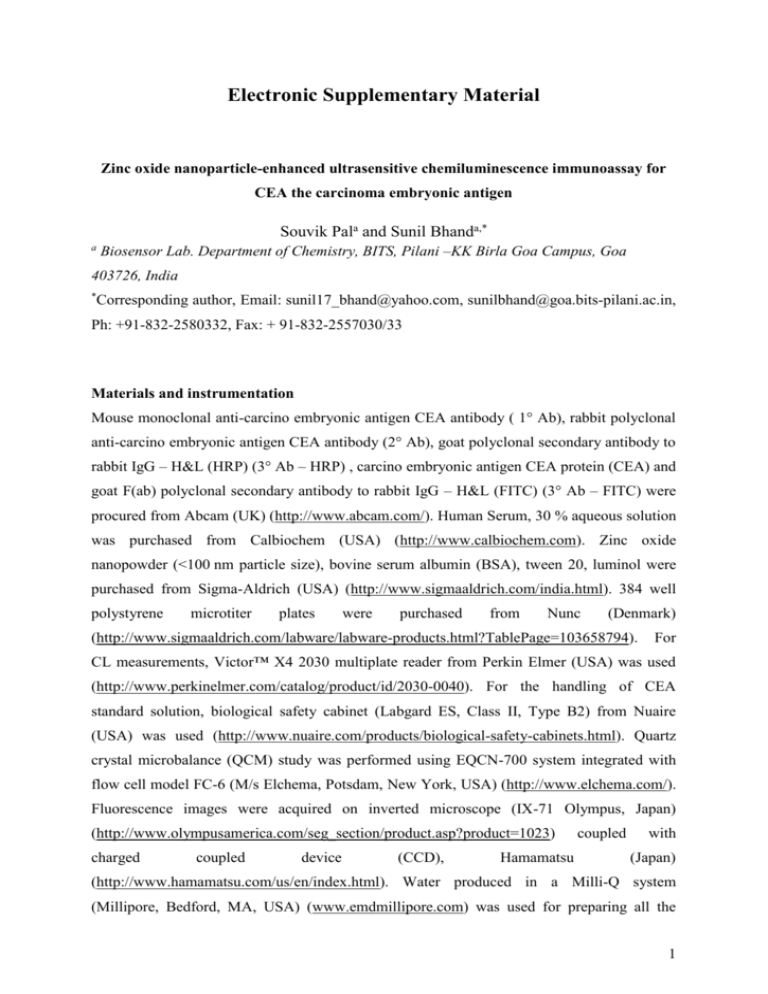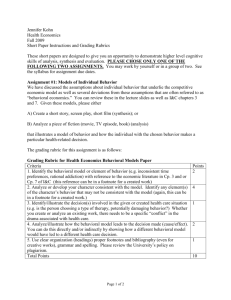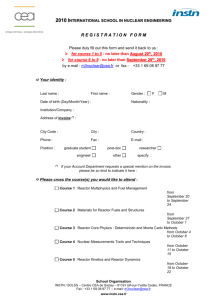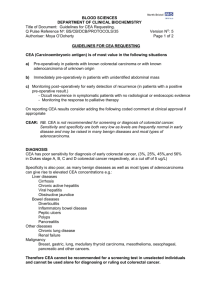Electronic Supplementary Material
advertisement

Electronic Supplementary Material Zinc oxide nanoparticle-enhanced ultrasensitive chemiluminescence immunoassay for CEA the carcinoma embryonic antigen Souvik Pala and Sunil Bhanda,* a Biosensor Lab. Department of Chemistry, BITS, Pilani –KK Birla Goa Campus, Goa 403726, India * Corresponding author, Email: sunil17_bhand@yahoo.com, sunilbhand@goa.bits-pilani.ac.in, Ph: +91-832-2580332, Fax: + 91-832-2557030/33 Materials and instrumentation Mouse monoclonal anti-carcino embryonic antigen CEA antibody ( 1° Ab), rabbit polyclonal anti-carcino embryonic antigen CEA antibody (2° Ab), goat polyclonal secondary antibody to rabbit IgG – H&L (HRP) (3° Ab – HRP) , carcino embryonic antigen CEA protein (CEA) and goat F(ab) polyclonal secondary antibody to rabbit IgG – H&L (FITC) (3° Ab – FITC) were procured from Abcam (UK) (http://www.abcam.com/). Human Serum, 30 % aqueous solution was purchased from Calbiochem (USA) (http://www.calbiochem.com). Zinc oxide nanopowder (<100 nm particle size), bovine serum albumin (BSA), tween 20, luminol were purchased from Sigma-Aldrich (USA) (http://www.sigmaaldrich.com/india.html). 384 well polystyrene microtiter plates were purchased from Nunc (Denmark) (http://www.sigmaaldrich.com/labware/labware-products.html?TablePage=103658794). For CL measurements, Victor™ X4 2030 multiplate reader from Perkin Elmer (USA) was used (http://www.perkinelmer.com/catalog/product/id/2030-0040). For the handling of CEA standard solution, biological safety cabinet (Labgard ES, Class II, Type B2) from Nuaire (USA) was used (http://www.nuaire.com/products/biological-safety-cabinets.html). Quartz crystal microbalance (QCM) study was performed using EQCN-700 system integrated with flow cell model FC-6 (M/s Elchema, Potsdam, New York, USA) (http://www.elchema.com/). Fluorescence images were acquired on inverted microscope (IX-71 Olympus, Japan) (http://www.olympusamerica.com/seg_section/product.asp?product=1023) charged coupled device (CCD), Hamamatsu coupled with (Japan) (http://www.hamamatsu.com/us/en/index.html). Water produced in a Milli-Q system (Millipore, Bedford, MA, USA) (www.emdmillipore.com) was used for preparing all the 1 solutions. Automated eppendorf Xplorer plus (8-channel) (Eppendrof AG, Germany) was used for liquid and sample pipetting (http://www.eppendorf.com/IN-en/). Optimization of experimental conditions Optimization of ionic strength and pH of buffer Several physicochemical factors that influenced the CL- ELISA performance were studied. To evaluate the influence of buffer ionic strength and buffer pH, standard curves were prepared. A constant concentration of 3° Ab-HRP was added to serial dilutions (from 100 to 1 mM PBS) of a concentrated buffer. Increment in signal intensity was found up to 10 mM. A slight decrease in signal intensity was observed for 50 mM and 100 mM. Influence of pH on the 1° Ab and 2° Ab was studied in the range 5.0 to 9.0. The optimum results for the ionic strength and pH of PBS were found at 10 mM, pH 7.4 (Figure S1 and S2). Signal intensity (ADU) 1600 1200 800 400 5 6 7 8 9 pH Figure S1: Optimization of pH of buffer (5.0 – 9.0) for ZnONPs based CEA immunoassay; in triplicate. Signal intensity (ADU) 2000 1600 1200 800 400 0 20 40 60 80 100 Ionic strength (mM) Supplementary Figure S2: Optimization of ionic strength of buffer (1 – 100 mM) for ZnONPs based CEA immunoassay; in triplicate. 2 Optimization of 3° Ab-HRP and ZnONPs The principle of the ZnO-NPs based immunoassay was based on a sandwich immunoassay as described in earlier section. Effective 3° Ab dilution is very important to produce reproducible results and reduce non-specific bindings, which might produce false signals. To examine appropriate amount of 3° Ab-HRP, various 3° Ab-HRP dilutions were tested. It was found that a 3° Ab-HRP dilution of 1:2000 produced better signal intensity against 1° Ab (0.2 µg·mL-1) (Figure S3). Further, the amount of ZnO-NPs – CEA probe particles was also optimized as 2 mg·mL-1, having maximum signal intensity (Figure S4). Signal intensity (ADU) 21000 1:100 1:200 1:500 1:1000 1:2000 1:4000 18000 15000 12000 9000 6000 3000 0 10 20 30 40 Time (min) Figure S3: Optimization of pAb-HRP (1:100 – 1:4000 dilutions) for ZnONPs based CEA immunoassay. Signal intensity (ADU) 24000 20000 16000 12000 8000 4000 0 1 2 3 4 -1 5 Amount of ZnO-NPs (mgmL ) Figure S4: Optimization of amount of ZnONPs (1 – 5 mg mL-1) for ZnONPs based CEA immunoassay. 3 Selectivity studies In the presence of possible interferences, such as glucose (Glu, 5 mM), ascorbic acid (AA, 10 µM), glycine (Gly), bovine serum albumin (BSA, 380 µg mL-1) and mixture, the developed immunosensor was studied for its selectivity in the incubation solution with 20 ng mL-1 CEA. The % I was calculated from the signal intensity values in the presence of the interference and without interference (Figure S5). 60 -1 Selectivity study against 20 ng.mL of CEA % Inhibition 50 40 30 20 10 ur e BS A M ixt Gl y AA Gl u CE A AA Gl u +C EA +C EA Gl y+ CE BS A A +C EA 0 Figure S5: Selectivity study using glucose (Glu, 5 mM), ascorbic acid (AA, 10 µM), glycine (Gly), bovine serum albumin (BSA, 380 µg mL-1) and mixture against CEA (20 ng·mL-1). 50 -1 Selectivity study against 2 ng.mL of CEA % Inhibition 40 30 20 10 Gl y AA Gl u CE A BS A M ixt ur e Gl u +C EA AA +C EA Gl y+ CE BS A A +C EA 0 Figure S6: Selectivity study using glucose (Glu, 0.5 mM), ascorbic acid (AA, 1 µM), glycine (Gly), bovine serum albumin (BSA, 38 µg mL-1) and mixture against CEA (2 ng·mL-1). In the presence of possible interferences, such as glucose (Glu, 0.5 mM), ascorbic acid (AA, 1 µM), glycine (Gly), bovine serum albumin (BSA, 38 µg mL-1) and mixture, the developed immunosensor was studied for its selectivity in the incubation solution with 2 ng mL-1 CEA. 4 The % I was calculated from the signal intensity values in the presence of the interference and without interference (Figure S6). In the presence of possible interferences, such as glucose (Glu, 0.05 mM), ascorbic acid (AA, 0.1 µM), glycine (Gly), bovine serum albumin (BSA, 3.8 µg mL-1) and mixture, the developed immunosensor was studied for its selectivity in the incubation solution with 0.2 ng mL-1 CEA. The % I was calculated from the signal intensity values in the presence of the interference and without interference (Figure S7). 40 -1 Selectivity study against 0.2 ng.mL of CEA % Inhibition 30 20 10 ur e BS A M ixt Gl y AA Gl u CE A AA Gl u +C EA +C EA Gl y+ CE BS A A +C EA 0 Figure S7: Selectivity study using glucose (Glu, 0.05 mM), ascorbic acid (AA, 0.1 µM), glycine (Gly), bovine serum albumin (BSA, 3.8 µg mL-1) and mixture against CEA (2 ng·mL-1). Signal intensity (ADU) mAb-16PHA-ZnO-NPs; mAb coated microwell plate 20000 15000 10000 5000 0 1 2 3 4 Time (Weeks) Figure S8: Comparison of stability of 1° Ab coated ZnONPs and microwell plate at storage condition 4 °C, 10 mM pH 7.4 PBS. 5 Table S1: Recovery of [CEA] from different serum samples as determined by CEA – ZnONPs nano-immunosensor to assess the recovery efficiency. ZnO-NPs – CEA immunoassay [CEA] added (ng·mL-1 ) [CEA] Found (ng·mL-1 ) Mean S.D. Microplate ELISA R.E. (%) Recovery (%) [CEA] Found (ng·mL-1 ) Mean S.D. R.E. (%) Recovery (%) 0.01 0.00988 0.00019 1.2 98.8 0.0104 0.0002 - 4.0 104 0.05 0.0487 0.00252 2.6 97.4 0.0453 0.00252 9.4 90.6 0.0283 - 10.14 110.14 1 0.986 0.007 1.4 98.6 1.1014 2.5 2.49 0.0264 1.0 99.6 2.50 0.0152 0.0 100.0 10 10.05 0.02 - 0.5 100.5 10.47 0.379 - 4.7 104.7 15 14.993 0.041 0.047 99.95 N.D.# - - 20 19.81 0.02 0.95 99.05 N. D. - - # Not determined Found [CEA] ng.mL -1 20 ZnO-NPs - CEA ELISA Conventional ELISA 16 12 8 4 Correlation coefficient = 0.99998 0 0 4 8 12 16 -1 Added [CEA] ng.mL 20 Figure S9: Correlation curve between two methods (Conventional ELISA and ZnO-NPs – CEA ELISA) with Pearson’s correlation coefficient (r) = 0.99998. Figure 10: Theoretically calculated correlation coefficient (r) between two methods (Conventional ELISA and ZnO-NPs – CEA ELISA). 6





